Even if you have limited experience with Indonesian food, there’s a chance you’ve at least heard of sate and nasi goreng. If you’ve been to Bali, then you’ve probably had your fair share of babi guling. But how many Indonesian desserts can you actually name?
Before spending time in Java and Bali, I could name one – cendol. Listed by CNN as one of the most delicious drinks in the world (though it’s really a dessert), this refreshing iced treat remains my favorite Indonesian dessert. But as you’ll soon see in this guide, it’s hardly the only sweet treat to look for in Indonesia.
From colorful kue to ginger-infused sweet soups like ronde, people with a sweet tooth will have lots to look forward to on their next trip to Indonesia.
INDONESIAN DESSERT QUICK LINKS
If you’re traveling to Indonesia and want to really dive into Indonesian cuisine, then you may be interested in joining a food tour or taking a cooking class.
TOURS & OTHER SERVICES
- Food Tours: Food Tours in Indonesia
- Cooking Classes: Cooking Classes in Indonesia
- eSIM: Indonesia eSIM
Save This on Pinterest!
No time to read this article on the most delicious Indonesian desserts? Click on the save button and pin it for later!

Photo by Cholifahcho2
MUST-TRY TRADITIONAL INDONESIAN DESSERTS
1. Cendol
Cendol isn’t just one of my favorite Indonesian desserts, it’s one of my favorite desserts period. Like nuoc mia in Vietnam, it’s something I look forward to on every return trip to Indonesia.
This traditional Indonesian dessert is made with strands of green rice flour jelly, palm sugar syrup, coconut milk, and shaved ice. The word cendol refers to the curious-looking strands of green rice flour jelly but it can be made with additional ingredients like sliced jackfruit, durian, black grass jelly, and sweetened condensed milk.
On a hot day in Indonesia, nothing compares to a glass or bowl of cendol. Earthy and almost caramel-ly in sweetness thanks to the palm sugar syrup, it’s delicious and incredibly refreshing.
If you’re a fan of Filipino halo-halo like I am, then I’ve got a good feeling you’ll enjoy cendol too.

Photo by E Dewi Ambarwati
2. Kolak Pisang Ubi
Dessert soups are common throughout Southeast Asia and Indonesia is no exception. In the Philippines, you’ll find ginataan while in Vietnam, you can enjoy che.
Kolak refers to a family of traditional Indonesian dessert soups made with a base of coconut milk and pandan leaves sweetened with either palm sugar or coconut sugar. Depending on the cook, it can be made with a variety of ingredients like bananas, jackfruit, cassava, rice balls, and sweet potatoes.
Pisang means “banana” while ubi translates to “sweet potato”, so kolak pisang ubi refers to a delicious type of kolak made with bananas and sweet potatoes.

Photo by Ika Rahma H
3. Ronde
If you aren’t used to the flavor of ginger, especially in a dessert, then the taste of this next Indonesian dessert soup may come as a shock to you.
Ronde is the Indonesian version of tangyuan, a traditional Chinese dessert made with glutinous rice balls served in a hot broth or syrup. It’s especially popular in Java where it’s consumed as a drink to warm you up during the colder winter months.
Indonesian ronde is made with rice balls of different colors and sizes served in a ginger- and pandan-infused syrup. The smaller balls are typically unfilled while the larger balls are made with a stuffing of ground peanuts and sugar.
Drinking the ginger syrup will make your throat feel warm and zingy. If you aren’t used to the taste of ginger, then it can be an odd sensation at first but it really does a good job of warming you up.
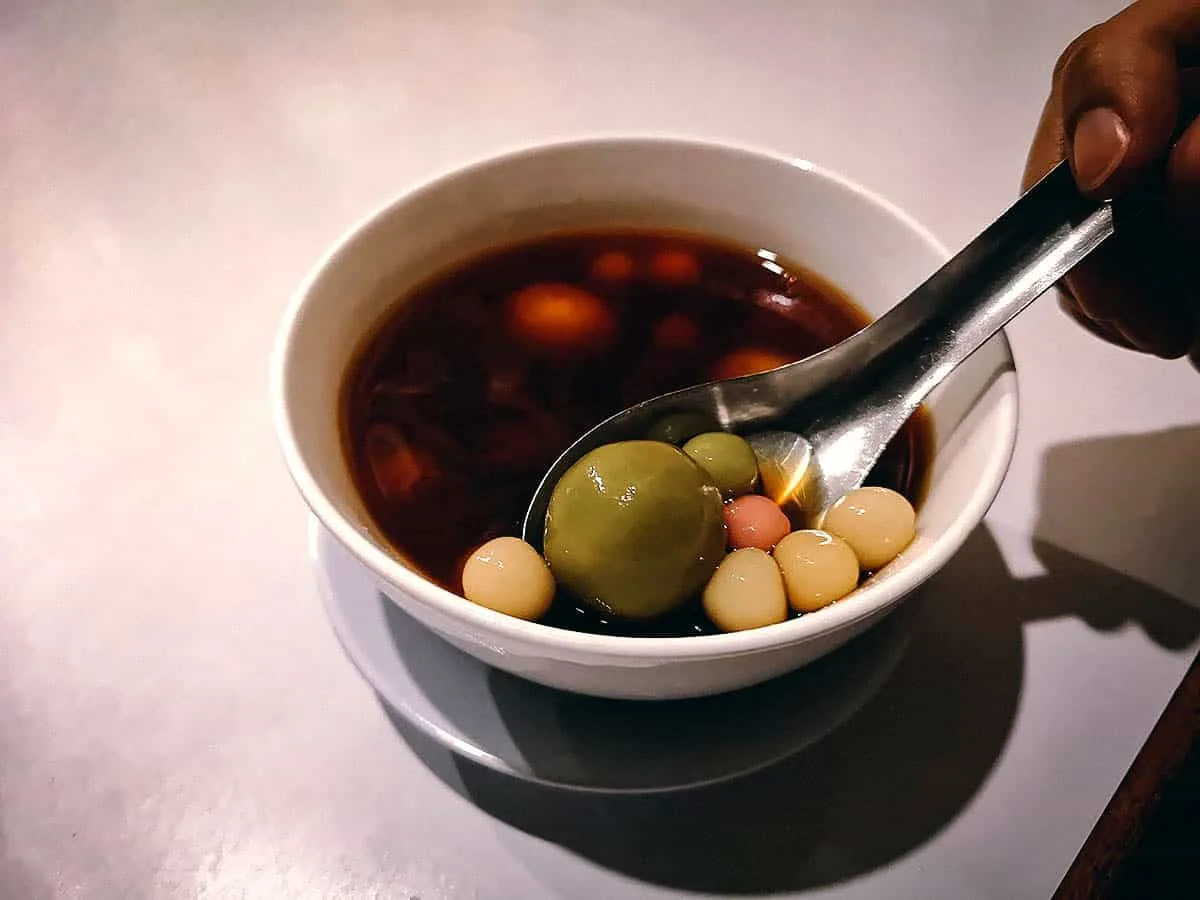
4. Pai Susu Bali
If you’ve been to the Island of the Gods, then you may be familiar with these tasty milk pies known as pai susu bali. Like pineapple cakes from Taiwan, it’s a popular snack that’s often brought home as a souvenir dessert from Bali.
Pai susu literally means “milk pie” and refers to an Indonesian custard tart that originated in Bali. Reminiscent of a Portuguese pastel de nata, it consists of a shortcrust pastry filled with a thin layer of egg custard and condensed milk.

Photo by Joseagush, CC BY-SA 4.0, via Wikimedia Commons / Processed in Photoshop and Lightroom
5. Pisang Goreng
Fried bananas are a popular dessert or snack in the Philippines so we were naturally drawn to this Indonesian fried banana dessert called pisang goreng.
Pisang goreng literally means “fried bananas” and refers to a simple but delicious Indonesian dessert made with batter-coated bananas deep-fried in hot oil. It can be made with different types of bananas like pisang raja, pisang saba, or plantains.
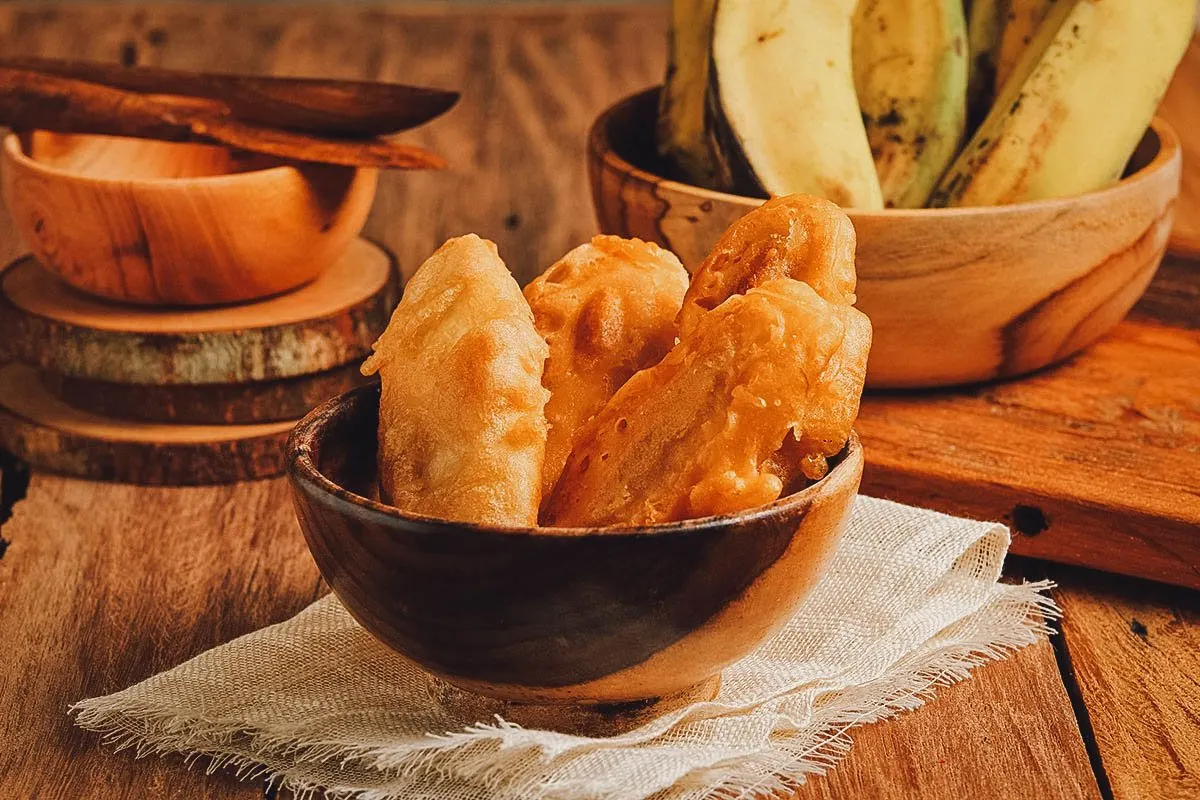
Photo by kalkasandi.gmail.com
6. Kue Lapis Legit
In Indonesia, you’ll find a wide variety of dessert delicacies called kue (kuih in Malaysia). It’s a broad term that covers a spectrum of snacks that include bite-sized cakes, cookies, pies, fritters, and pastries. Like wagashi in Japan, I don’t completely understand what qualifies as kue because you’ll find so many of these small colorful snacks in Indonesia!
Based on what I’ve read, Indonesian kue is traditionally made with rice flour and coconut milk but these days, they’re often made with wheat flour and other dairy products as well. They can be sweet or savory; steamed, baked, or fried; and made with a wide variety of different ingredients. You see why it’s so confusing??
You’ll find a seemingly endless variety of kue in Indonesia but one of the most eye-catching is kue lapis legit. Also known as spekkoek, it refers to a Dutch-Indonesian layer cake made with flour, eggs, butter (or margarine), sugar, and spices. It’s a pretty but labor-intensive cake that typically contains over eighteen layers.
It’s worth noting that kue lapis legit is different from the similarly named kue lapis. The former is a baked layered cake while the latter is a steamed layered rice and coconut pudding made with glutinous rice flour, coconut milk, sugar, and food coloring.

Photo by Kristina Ismulyani
7. Bika Ambon
If you visit Medan in Indonesia’s North Sumatra province, then one dessert that you definitely need to try is bika ambon. It’s an interesting type of Indonesian honeycomb cake made with tapioca flour, coconut milk, eggs, sugar, and yeast.
Bika ambon is known for its distinctive cavities formed by yeast in the dough. As the cake bakes, the yeast creates bubbles that give bika ambon its unique sponge-like texture.
Traditionally, bika ambon is flavored with banana or pandan leaves but they’re now enhanced with other flavorings as well like mandarin orange, vanilla, chocolate, and durian.
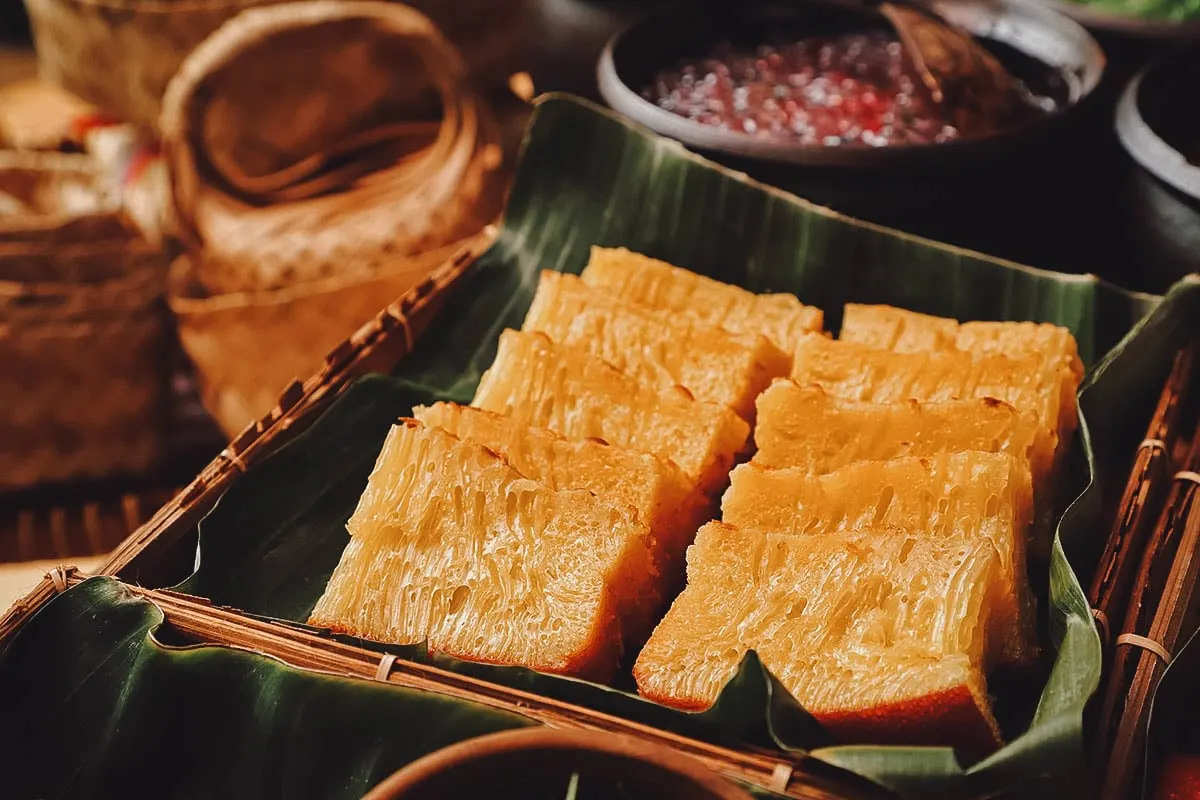
Photo by Ariyani Tedjo
8. Kue Wajik
Sweet with a sticky palm sugar glaze, wajik is a popular type of kue made with glutinous rice flour, coconut milk, and palm sugar. Its name literally means “diamond cake” thanks to its parallelogram- or rhombus-like shape. This sweet and sticky rice dessert is traditionally cut into diamond shapes before serving, though it can be made into other shapes as well.
Known as pulut manis in some parts of Indonesia, wajik is often wrapped in banana leaves or dried corn husks and eaten as an afternoon snack. It’s also a common sight at Indonesian weddings because the sticky rice is meant to symbolize a “sticky” or lasting marriage.
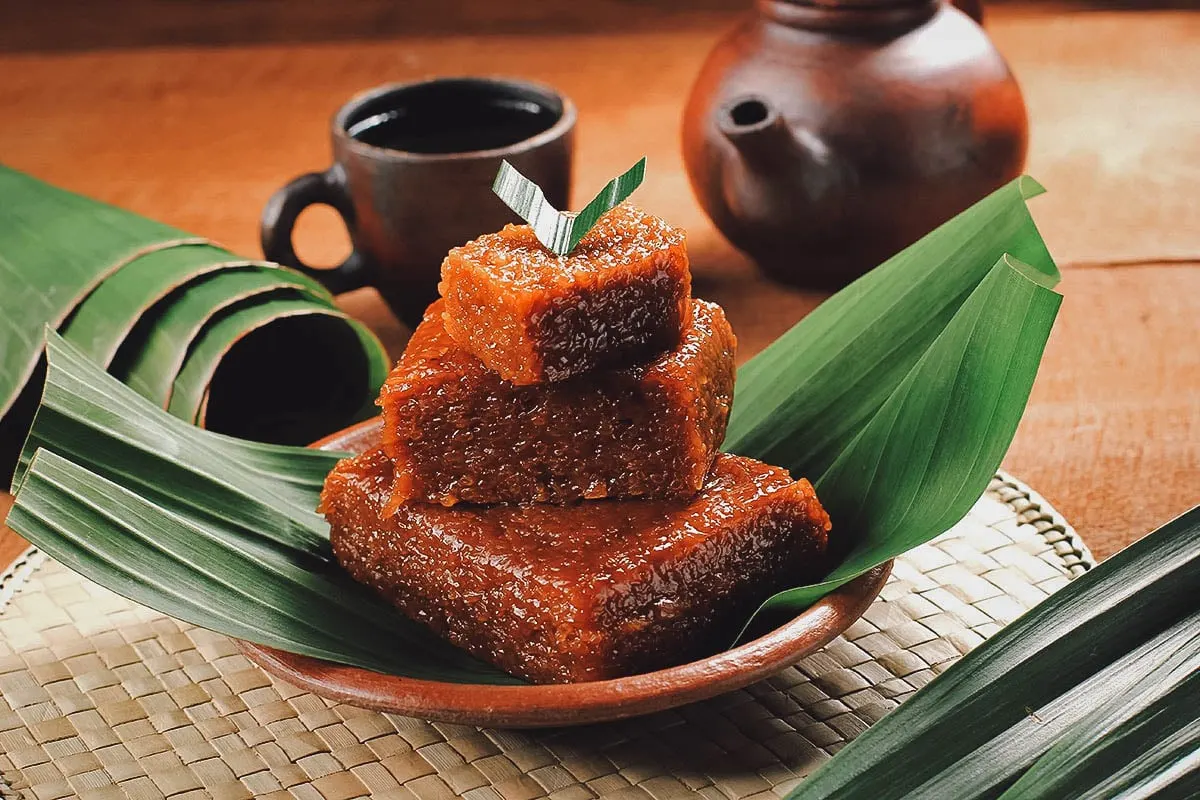
Photo by Ika Rahma H
9. Kue Dadar Gulung
Desserts made with pandan leaves never fail to catch my eye (or nose). Fragrant and verdant, kue dadar gulung refers to a traditional Indonesian dessert made with thin rolled-up rice flour pancakes filled with grated coconut and palm sugar.
At first glance, you’d think these coconut pancakes get their bright green color from artificial food coloring, but they don’t. They get their coloration and aroma from pandan leaves which are often used as an aromatic ingredient in Southeast Asian cooking. Aren’t they pretty?
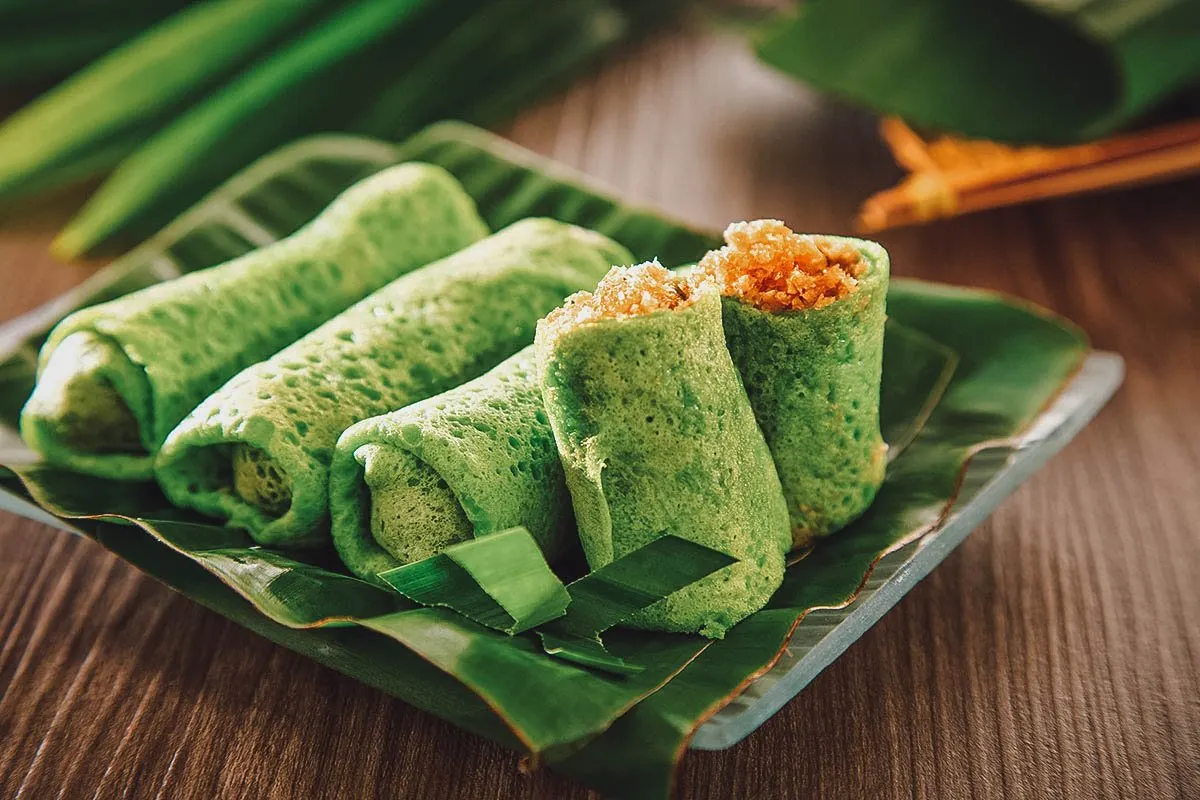
Photo by tehcheesiong
10. Kue Ongol Ongol
Ongol ongol refers to a type of kue originally from West Java. Soft and bouncy in texture, you can think of it as an Indonesian version of mochi made with palm sugar, grated coconut, and starch.
Depending on the type of starch it’s made with, ongol ongol can take on slightly different names like ongol ongol hunkwe (mung bean flour), ongol ongol singkong (grated cassava root), and ongol ongol kanji (tapioca starch).

Photo by Eva Hidayah
11. Bingka Telur Pandan
As its name and color suggest, bingka telur pandan is one of many Indonesian desserts on this list made with pandan leaves. It’s a more colorful variation of bingka telur – a simple Indonesian cake made with flour, eggs, coconut milk, sugar, and vanilla.
Bingka telur is delicious enough on its own but it becomes even better when enriched with the flavor and aroma of pandan.
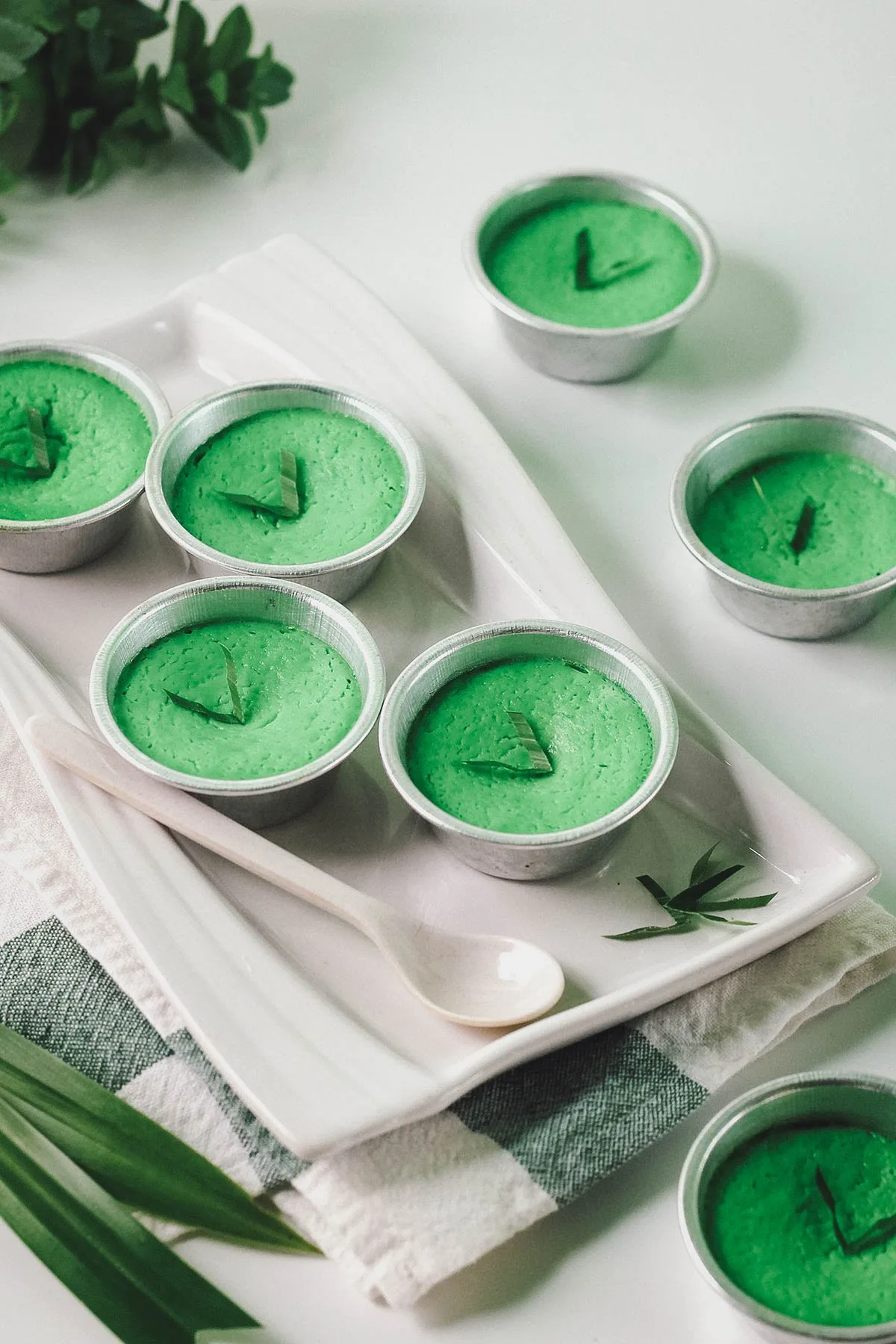
Photo by Cholifahcho2
12. Kue Nagasari
Nagasari refers to a type of banana-stuffed Javanese steamed cake. A local favorite, it’s made by stuffing ripe banana slices into a rice flour and coconut milk batter, wrapping it in banana leaves, and then steaming.
The version of nagasari pictured below is colored white but this popular Indonesian dessert takes on a green color when made with pandan leaves.

Photo by Yun Octavia
13. Kue Putu
If you’re familiar with Filipino puto bumbong, then this next Indonesian dessert will sound familiar to you. Kue putu is made with pandan-infused rice flour that’s filled with palm sugar and then steamed in bamboo tubes. Like the Filipino version, it’s traditionally eaten with desiccated or grated coconut.
Kue putu is especially popular in Java where it’s known as, get this, putu bumbung. I can’t say for sure who influenced who but there’s clearly a connection. Finding these cultural connections through food is one of the things I enjoy most about travel.

Photo by Herman Suparman
14. Klepon
These dessert bombs called klepon (or kelepon) are Indonesian sweet rice cakes filled with palm sugar and coated in grated coconut. I call them “dessert bombs” because they aren’t filled with just palm sugar – they’re filled with molten palm sugar! Biting into these delicious Indonesian desserts really does feel like an explosion of earthy sweetness in your mouth.
To prepare, small pieces of solid palm sugar are stuffed into a dough made with glutinous rice flour and pandan leaves. The dough balls are then boiled which melts the palm sugar and creates a molten core.
I’ll never forget the first time I tasted klepon. It was at a restaurant in Bali. Served warm, I didn’t know what to expect so I was pleasantly surprised when my mouth was filled with an earthy sweet liquid after taking a bite. This sweet rice cake is absolutely delicious and easily one of my favorite Indonesian desserts.
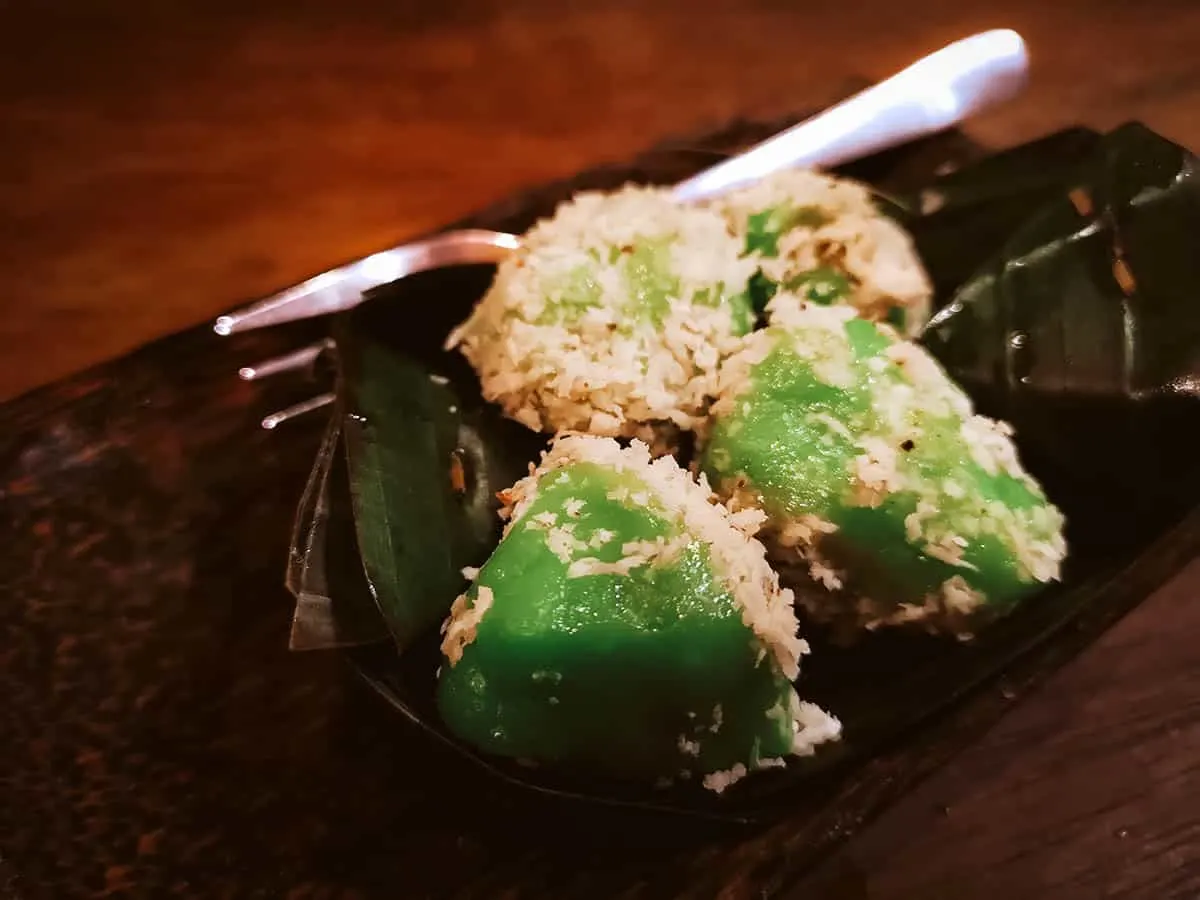
15. Kue Bugis
Kue bugis looks similar to klepon except it isn’t made with a molten palm sugar core. It consists of a dough made with sticky rice flour, coconut milk, sugar, and pandan extract. The dough is filled with a coconut sugar mixture before being wrapped in banana leaves and then steamed.

Photo by Rani Restu Irianti
16. Bola-Bola Ubi
Bola-bola ubi literally means “sweet potato balls”. It’s a traditional Indonesian street food snack or dessert consisting of deep-fried dough balls made with sweet potatoes, flour, and sugar.
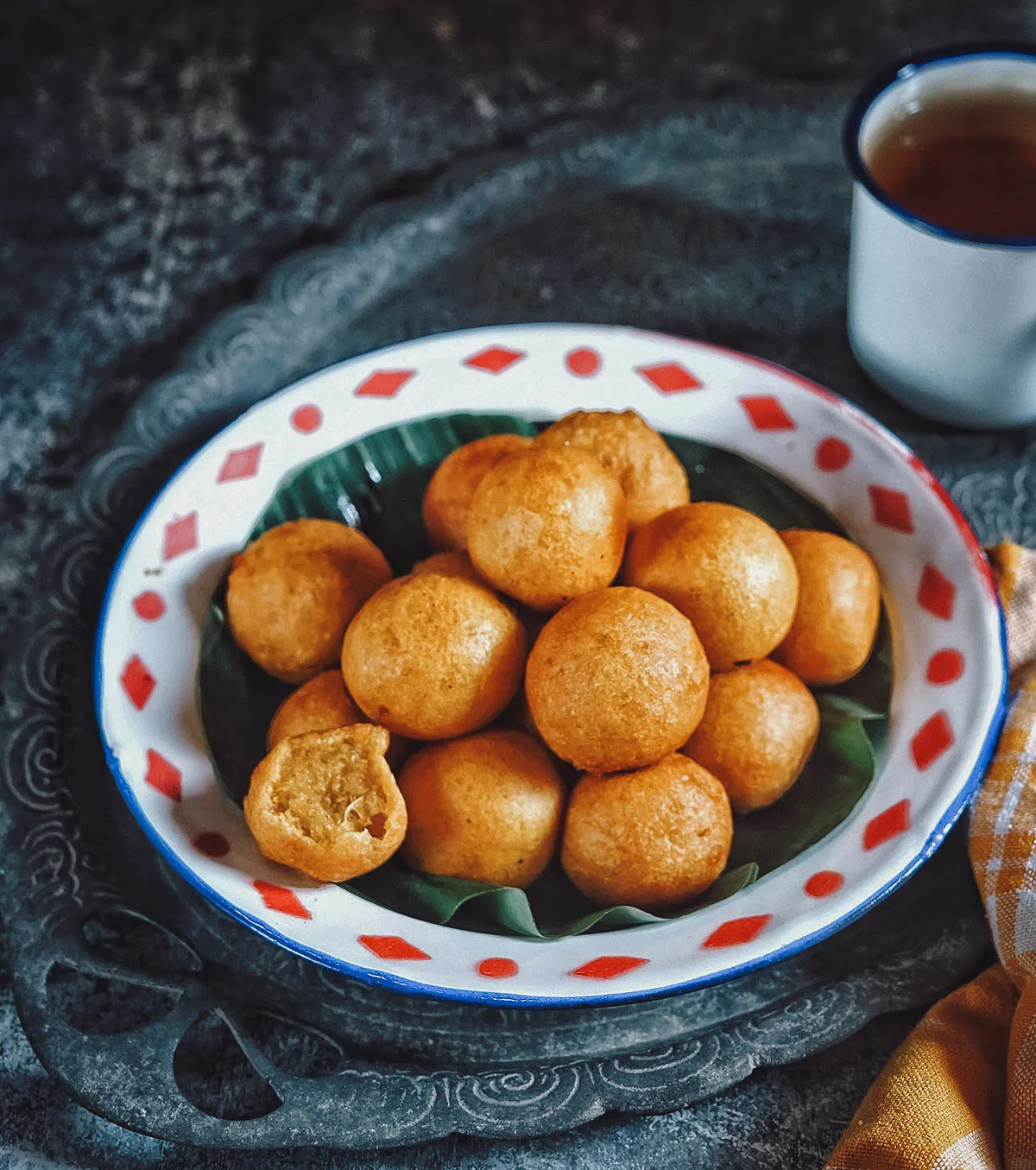
Photo by Hanifah Kurniati
17. Putu Ayu
Putu ayu is another Indonesian dessert that originated in Java. It’s basically a steamed pandan cake made with flour, eggs, coconut milk, pandan leaves, sugar, and grated coconut.
If you look at the picture below, you’ll notice that the grated coconut isn’t sprinkled on top of the cake. What makes putu ayu interesting is that it consists of two layers – a green pandan layer at the bottom and a white top consisting of grated coconut.
Typically steamed in mini bundt cake or flower-shaped molds, ayu means “pretty” in Indonesian, which is a good way of describing this eye-catching two-tone Indonesian cake.

Photo by Rizvisual
18. Martabak
Martabak manis is one of my favorite Indonesian desserts. It’s known as martabak in Indonesia but murtabak refers to a family of sweet and savory stuffed pancake dishes common throughout Southeast Asia and the Arabian peninsula.
In Indonesia, the savory version is known as martabak telur while the sweet dessert is called martabak manis. The latter consists of a thick sweet pancake topped with a wide variety of ingredients like chocolate, condensed milk, durian spread, bananas, matcha, and cream cheese. The martabak can be served as is or folded in half for easier eating.
This traditional Indonesian snack is one of the most popular street foods in the country. You shouldn’t have any trouble finding martabak no matter where you are in Indonesia.
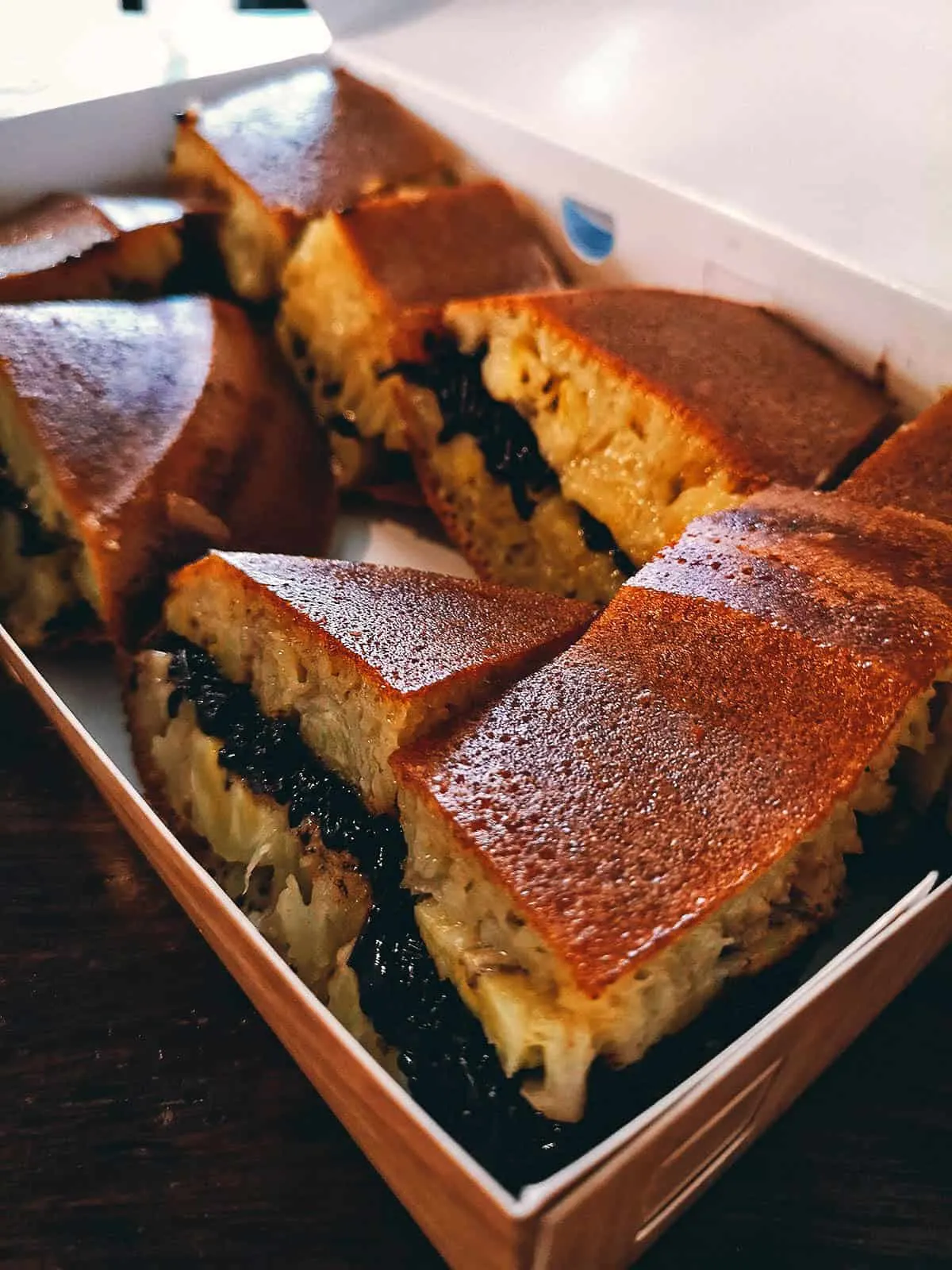
19. Surabi
Surabi (or serabi) is a traditional Javanese-Balinese snack or dessert similar to a pancake. Made from a batter of rice flour and coconut milk, it can be enjoyed in sweet and savory versions, much like martabak.
Sweet surabi is traditionally eaten with kinca – a coconut sugar topping made from grated coconut and liquid palm sugar. However, more modern versions are now made with a variety of different ingredients like jackfruit, durian, cream cheese, and chocolate sprinkles.

20. Colenak
Last but not least is colenak, a simple but delicious Indonesian dessert hailing from the province of West Java. Like ronde, it’s something you should look for when you visit the provincial capital of Bandung.
The main ingredient in colenak is peuyeum or fermented cassava. The fermented cassava is roasted on charcoal before being served with kinca.
If you’re drawn to uncommon ingredients, then you should definitely try colenak. Interestingly, the name colenak is a portmanteau word for dicocol enak, which translates to “delicious dip”.
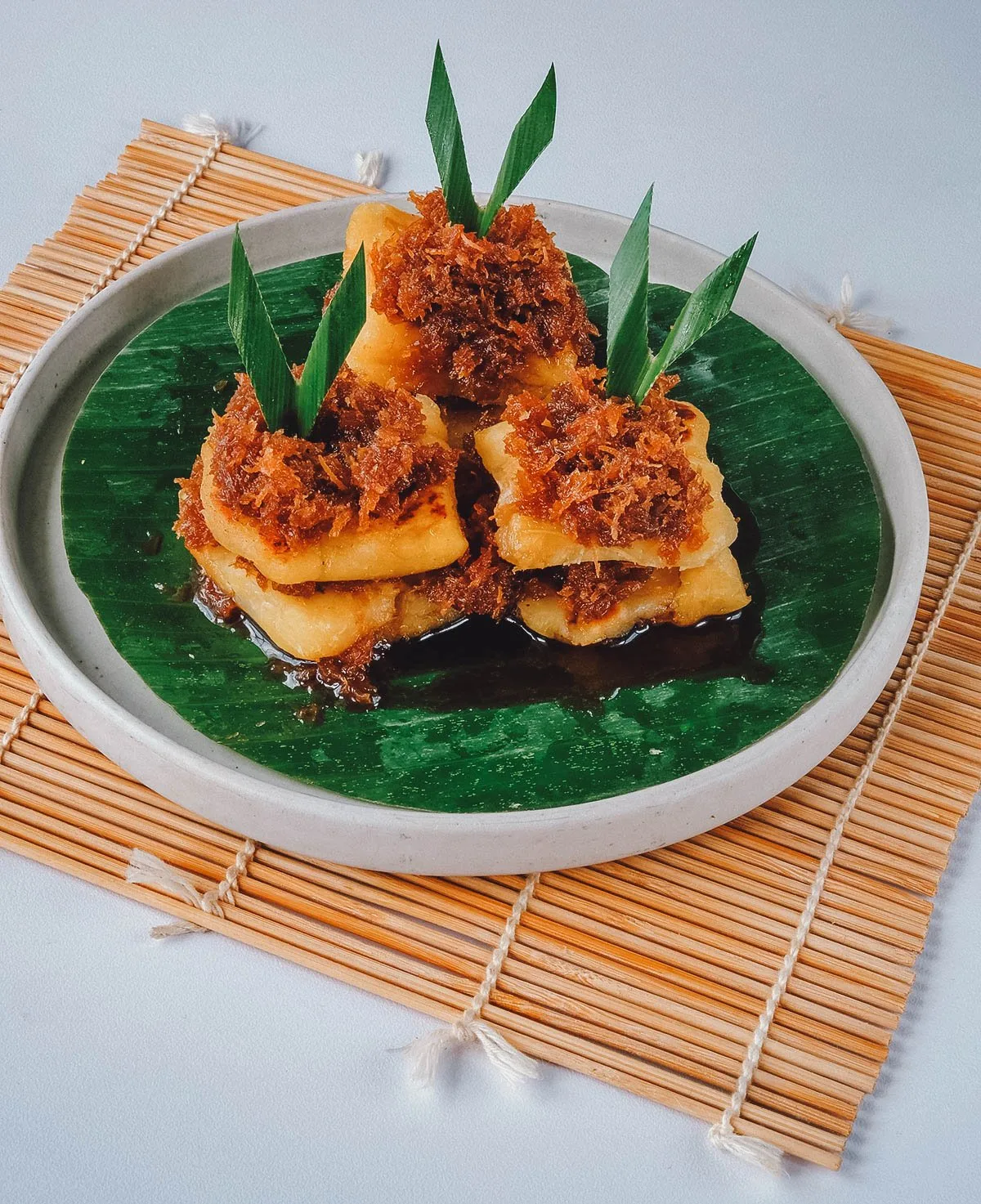
Photo by Sassi Photoworks
FINAL THOUGHTS ON INDONESIAN DESSERTS
To be honest, I prefer savory over sweet. Delicious Indonesian dishes like sate and babe guling will always be my jam but it’s nice to have refreshing desserts like cendol and klepon to enjoy right after.
With so many islands and provinces to visit, you certainly won’t run out of tasty desserts to satisfy your sweet tooth in Indonesia!
Disclosure
This article on popular Indonesian desserts contains affiliate links, meaning we’ll earn a small commission if you make a booking at no additional cost to you. As always, we only recommend products and services that we use ourselves and firmly believe in. We really appreciate your support as this helps us make more of these free travel and food guides. Thank you!
Cover photo by Ariyani Tedjo. Stock images via Shutterstock.

